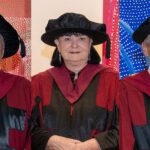Ground-breaking research revealing the origins of live birth from the discovery of 380 million year old fish fossils has been announced as a finalist in the Scientific Research category for the prestigious 2011 Eureka Awards.
The discovery was made by a team of scientists, including Curtin University’s vertebrate palaeontologist, Professor Kate Trinajstic, and uncovered fossils with intact embryos and umbilical cords, pushing back the believed origins of live birth a further 200 million years and revealing the history of complex copulatory sex in our own distant human lineage.
Professor Trinajstic said the scientists’ goal was to investigate the internal structure of fossils without using destructive techniques.
“Before the use of CT scanning to obtain high level data for new discoveries about fossil anatomy, the fossil had to be cut into sections which gave excellent results but sadly destroyed the fossil,” Professor Trinajstic said.
“Analysis of these fossils has only been made possible through new application of innovative technologies, in particular the use of the one of the world’s finest XCT scanners in the Department of Applied Mathematics, at Australian National University (ANU), for imaging the tomography of the specimens.
“We also applied Drishti, an internally developed software program for 3-D image analysis.”
Professor Trinajstic said the team had focussed on solving questions that had arisen from initial discoveries in the field and looked widely at how new data could be applied to the other broader fields, such as evolutionary developmental biology.
“The discovery of these fossils led our team to identify the first data on ancient reproductive behaviour in an extinct class of animals (Placodermi) and how the pattern developed in their pelvic fins, which were modified for copulation and immediately showed characteristics linking sharks and placoderms,” she said.
“We then examined specimens from the British Museum of Natural History and the Western Australian Museum to identify the first ever fossil embryos in the largest, most diverse order of placoderms, the Arthrodira.
“This revealed that internal fertilisation in vertebrates was much more widespread than previously imagined and had major implications to the evolutionary development of basal jawed vertebrates.”
Professor Trinajstic said the use of cutting-edge technologies for analysis in palaeontology was relatively new and brought unique, wider implications to the fields of biology and evolutionary theory.
“There is now a rigorous cross-disciplinary approach combined with an aggressive field program to successfully uncover extremely rare, extraordinary new fossils that provide new data and is leading us to new conclusions,” she said.
“The innovative approach first started by our team of researchers has already led to other countries developing their own micro-CT program for palaeontological research.
“The Institute of Vertebrate Palaeontology and Palaeoanthropology in Beijing, China, has recently acquired its own micro-CT scanner. Similarly the research group has adopted Drishti for their analysis of CT and tomographic data.”
Professor Trinajstic is a vertebrate palaeontologist who uses biochemical analytical methods to analyse the nature of rare soft tissues in fossils. She specialises mainly in the fish fauna from the Kimberley Region of Western Australia. In late 2010, Professor Trinajstic was awarded one of the Prime Minister’s prizes for science, the $50,000 Malcolm McIntosh Prize for Physical Scientist of the Year.
Between 2008 – 2009 Professor Trinajstic and her research team led by Dr John Long of Los Angeles County Museum, and including Professors Tim Senden and Gavin Young, both of ANU, published three landmark papers based on this research in the prestigious journal Nature.
Award winners for the 2011 Eureka Prize will be announced on 7 September.
Contacts:
Associate Professor Kate Trinajstic, Department of Chemistry, Curtin University
Tel: 08 92662492, Email: k.trinajstic@curtin.edu.au
Andrea Barnard, Public Relations, Curtin University
Tel: 08 9266 4241, Email: andrea.barnard@curtin.edu.au
Web: http://curtin.edu.au



